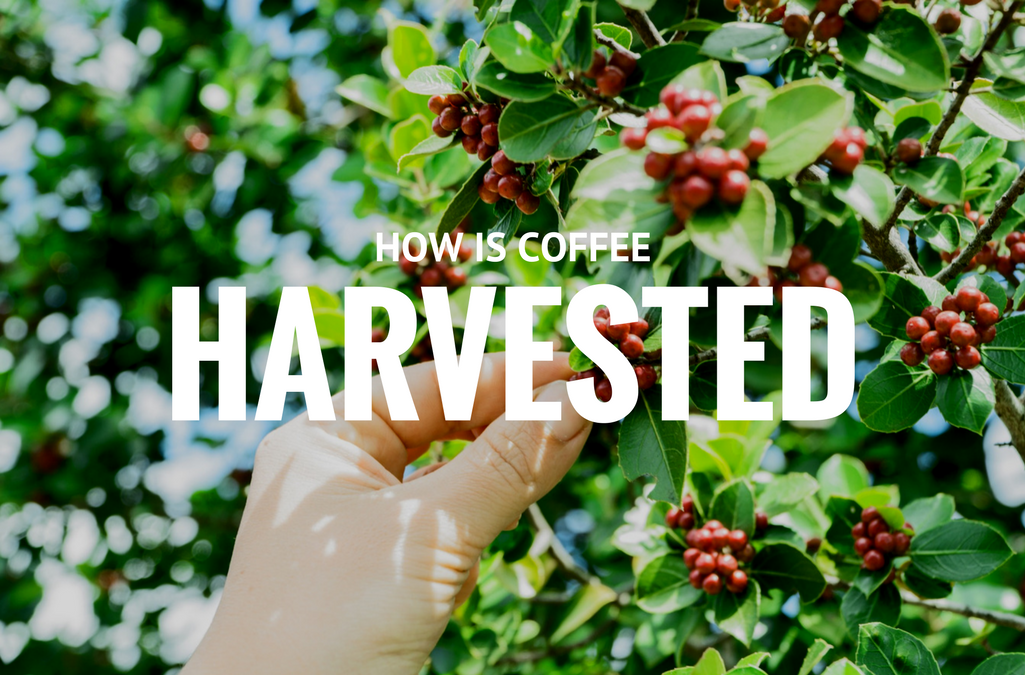Coffee is all processed in different ways. From seed to cup there are countless decisions and different ways to do things, and only after serious experimentation and research will a coffee reach it’s true potential.
Coffee harvesting is the first step of the fully grown cherries coming to our cups, and there are two methods that are used.
Selective harvesting is the picking of only the ripe coffee cherries by hand. Only the ripe cherries are picked, while the unripe cherries are left of the tree, to be reassessed a few weeks later. This process is repeated until all the viable coffee has been picked.
It’s an extremely labour intensive method, with pickers setting out and filling baskets hung around the waist. Then these baskets are emptied into larger collection bags where at the end of the day, the harvest is spread out and any foreign debris and overripe fruit is removed. Then finally the cherries are taken to be weighed and payment is apportioned.
There are a few advantages to this harvesting method, that help the coffee produced to be as high quality as possible. As only ripe fruit are picked, a lower percentage of un-ripes in the harvested coffee leads to higher prices for producers. When coffee is picked by hand, trees are able to be planted in steep slopes, easily navigated by humans but not so much by machines, leading to more efficient use of other land for farming.
But as hand picking is labor intensive, the farms require a large labour force that is willing to work for minimal pay. As well as this, wage increases mean that producers are less able to afford the cost involved with employing that many people. This method is also suffering, as increasing urban populations mean the rural workforce is declining in availability.
So what’s the alternative?
Strip harvesting is where all the coffee fruit is mechanically stripped from the trees, in one go. This results in harvests of varying maturation levels but is much less intensive and expensive.
There are three ways of strip harvesting, the first being manual stripping. This process involves pickers placing canvas on the ground, grabbing the branch of the tree and pulling outwards, knocking off all the fruit onto the canvas. The coffee is then collected in bags and taken to be weighed, where pickers are paid by weight or volume.
The next kind is mechanical stripping. It’s very similar to manual stripping, but the pickers receive some mechanical assistance. The pickers use a tool called “derricadeiras“, mechanical strippers that look like Freddie Kruger’s hands. The tool has metal fingers which knock the coffee onto the waiting canvas.
The third way of strip harvesting coffee is using a mechanical harvester. Machines, first introduced in the 70’s, use rotating and vibrating mallets to knock the fruit into collection units. They are able to minimise the yield of unripe cherries by adjusting the rotation and vibration rates and the speed of the whole machine. Another technique is to remove the lower mallets from the machine at the start of the harvest, as the top of the tree tends to ripen earlier, then go back and harvest the bottom of the trees when they become ripe. This method does require flat topographies to accommodate the machines.
Strip harvesting requires FAR less labor and means a harvest can be complete much faster than selective stripping. But as the harvesting is less specialised, varying levels of maturation are produced, and if they are not separated can lead to un-uniform drying and therefore a lower quality product. As well as this, more technology post harvest is required, to asses the size and maturation, including pulpers and optical sorters. Finally, as much unripe fruit is harvested, it goes to waste, reducing the quality and quantity of the final product, often meaning less profit for producers.
Each harvesting method has it’s clear benefits and drawbacks, and as just one part of the process growers must decide based on budget, desired overall coffee quality, geography and topography of the land, and availability of labour. One method can’t really be considered better than another, it really varies from farm to farm.




5 comments
Nazeer
Please send
Please send
Coffee Production 101: How Is Coffee Produced & Processed?
[…] Another alternative to manual harvesting is with the use of a mechanical stripper known as a derriçadeira. The fingers run through the branches of the coffee plants, collecting the falling cherries onto the canvas.6 […]
[…] Another alternative to manual harvesting is with the use of a mechanical stripper known as a derriçadeira. The fingers run through the branches of the coffee plants, collecting the falling cherries onto the canvas.6 […]
Why is coffee so expensive?? - DripBeans
[…] The coffee is often harvested annually, but there are countries with a climate that allows harvesting two times each year. This affects, of course, the price as well. If the farmers would have the possibility to farm more often, they would be able to produce more coffee from less land which would have resulted in lower prices. […]
[…] The coffee is often harvested annually, but there are countries with a climate that allows harvesting two times each year. This affects, of course, the price as well. If the farmers would have the possibility to farm more often, they would be able to produce more coffee from less land which would have resulted in lower prices. […]
Ryadan Jeavons
Whilst I’m aware they do that with other fruit like bananas and tomatoes, I haven’t heard of them doing this with coffee cherries. Usually, they wait until the majority of the cherries are ripe and then harvest. eg: if the ripening began in Oct, they might start harvesting in Dec/Jan to ensure that more than 80% are ripe.
Whilst I’m aware they do that with other fruit like bananas and tomatoes, I haven’t heard of them doing this with coffee cherries. Usually, they wait until the majority of the cherries are ripe and then harvest. eg: if the ripening began in Oct, they might start harvesting in Dec/Jan to ensure that more than 80% are ripe.
Veera
Don’t they use chemicals to have the cherries ripen synchronously (except for organic coffee perhaps)?
Don’t they use chemicals to have the cherries ripen synchronously (except for organic coffee perhaps)?